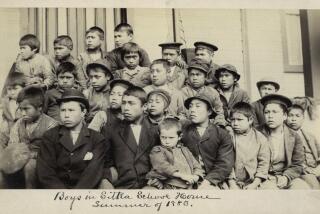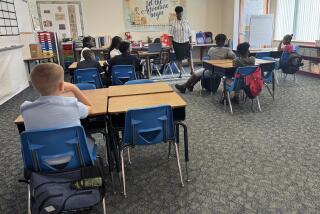Neil Sullivan, 90; Led Fight to Desegregate Schools in Virginia, Boston, Berkeley
Neil Sullivan, an innovative school administrator who pushed for school desegregation in the 1960s during pivotal battles in Prince Edward County, Va., and Berkeley, Calif., died Aug. 6 of congestive heart failure at his home in Meredith, N.H. He was 90.
The son of poor Irish immigrants, Sullivan was swept into the school desegregation movement after hearing The Rev. Martin Luther King Jr. speak at the historic March on Washington in 1963. The civil rights icon introduced Sullivan to then-U.S. Atty. Gen. Robert F. Kennedy, who sent Sullivan into a hotbed of anti-desegregation fervor.
Sullivan became superintendent of the Prince Edward County Free Schools, which were created to serve black students who had been shut out of public schools. He went on to craft a plan for Berkeley that made it the first large city to integrate all its schools without a court order.
“He was a pioneer on civil rights and brought decent education into the lives of children who had never before been offered the opportunity,” Sen. Edward M. Kennedy (D-Mass.) said in a statement Wednesday. “He was a close advisor on education policy to my brother Bobby, and the entire Kennedy family mourns his passing.”
The son of a bartender who lost his job during Prohibition, Sullivan grew up in crowded tenements in Manchester, N.H. After serving in the Navy during World War II, he went to Harvard University on the G.I. Bill, earning a PhD in education in 1956. He quickly rose through the ranks to top administrative posts in school systems in Maine and New York.
In the summer of 1963, Sullivan was superintendent at a suburban Long Island school district when a Justice Department official summoned him to Washington to discuss the problems in Prince Edward County.
In 1959, five years after the landmark Brown vs. Board of Education ruling against “separate but equal” schools, Prince Edward had closed its schools to circumvent court-ordered desegregation. The closures deprived 1,800 black students of a public education, while the county’s 1,500 white students attended a private academy financed partly with state funds.
The situation led President John F. Kennedy to remark at a news conference that there were only four places in the world where children were denied the right to attend school: North Vietnam, Cambodia, North Korea -- and Prince Edward County. He ordered the Justice Department to find a way to reopen Prince Edward County’s schools, which by 1963 had been shuttered for four years.
The result was a plan for the racially integrated Free Schools.
Sullivan was tapped for the job in part because of his success in New York running a non-graded school system, in which students progressed through subjects as quickly as their abilities dictated, regardless of their age. This system made sense to officials trying to help Prince Edward County’s black children make up for lost years of learning.
Sullivan moved his wife, Martha, and college-age sons, Michael and Roger, to Farmville, the Prince Edward County seat, for a tense year of struggle.
He had only three weeks to hire a staff, order supplies and ready four dilapidated campuses filled with trash no one had bothered to remove when the schools were abruptly closed. But on Sept. 16, 1963, he opened the Free Schools with 1,520 students, of whom four were white.
The students had plenty of catching up to do. Sullivan noted that on the first day of class none of them knew to salute the flag or recognized the national anthem. He announced that the schools would mount “a mass attack” on poor reading skills and kept classrooms open until 5:30 p.m. on weekdays and on Saturdays.
But four years of lost schooling had done irreparable harm. Many 9- and 10-year-olds were ignorant of the alphabet, while students in their teens could read at only a third- or fourth-grade level.
Before the first day of school ended, “it had been forcibly brought home to us that a majority of students under 12 didn’t know left from right, back from front, or top from bottom. And getting them to say even a word or two was next to impossible,” Sullivan wrote in “Bound for Freedom,” his 1965 memoir about his experiences in Prince Edward County.
Deepening the challenge was the reaction of angry whites.
Sullivan’s house was firebombed, garbage was dumped in his driveway and a shotgun blast through a window nearly knocked him out of bed. Threats came through the mail and in phone calls at all hours of the night. Ultimately, federal marshals were assigned to protect him and his staff.
“It was a living hell,” Sullivan told an interviewer years later.
But there was good news as well. Money flowed in from individuals and organizations around the country, providing the $1 million needed to run the schools for a year. By spring of 1964, the Free Schools received state certification, which meant its graduates were qualified to apply to colleges and universities in Virginia.
Half the 23 high school seniors planned to attend college, “an unprecedented proportion by pre-Free School standards,” Sullivan had said. According to test scores, the majority of the 1,500 elementary and secondary students had advanced an average of two years scholastically after only 10 months back in school.
The best news came May 25, 1964, when the U.S. Supreme Court unanimously ordered Prince Edward County to reopen its public schools.
Sullivan was free to return to his comfortable position as a schools superintendent on Long Island, but he felt it would be “cowardly” to do so after succeeding in Prince Edward County against such long odds. So when another challenge was offered -- in Berkeley -- he readily accepted.
Despite its growing reputation as a liberal stronghold, Berkeley in the 1960s was a segregated city, with whites concentrated in the hills and blacks in the flatlands.
When the school board voted in 1964 to desegregate the city’s junior highs, a recall campaign was launched against those who supported the move.
Voters rejected the recalls by a wide margin, giving the board -- and its new superintendent, Sullivan -- a mandate to desegregate the lower schools.
In 1966, Sullivan instituted voluntary desegregation of the elementary schools, then worked with a citizens committee to devise a mandatory plan. The result was the Berkeley Plan, which aimed for racial balance by busing white children to schools in the flats and black children to schools in the hills. Such “two-way” busing distinguished Berkeley from other cities where mostly black students were bused.
When the plan was approved in 1968, Berkeley became “the only city in the nation to institute comprehensive two-way elementary school busing for desegregation” without a court order compelling it, according to Berkeley historian Charles Wollenberg.
The program remained in effect for 25 years.
“School integration can change attitudes -- that is the key factor,” Sullivan, explaining his commitment to desegregation, wrote in “Now Is the Time,” his 1969 book about the Berkeley experiment. “It is our hope that in the integrated school we shall not raise another generation of bigots.”
After Berkeley, Sullivan moved to Massachusetts, where as commissioner of education from 1969 to 1972 he fought to uphold desegregation during violent struggles over forced busing in Boston and other cities.
He concluded his career on the West Coast as chairman of the education administration department at Cal State Long Beach. He retired in 1984.
Sullivan is survived by sons Roger of Marblehead, Mass., and Michael of Moultonborough, N.H.; three grandchildren; and four great-grandchildren.
More to Read
Sign up for Essential California
The most important California stories and recommendations in your inbox every morning.
You may occasionally receive promotional content from the Los Angeles Times.











